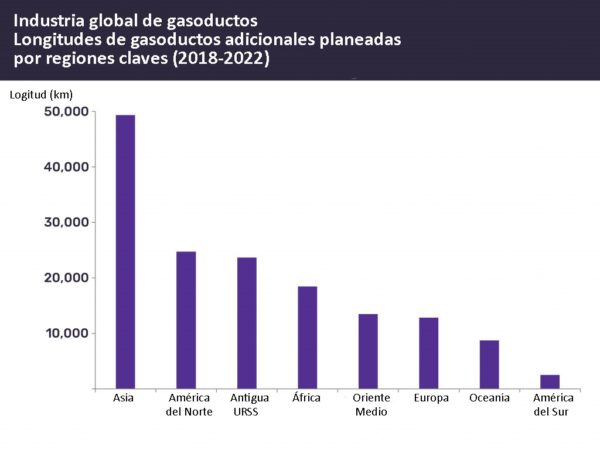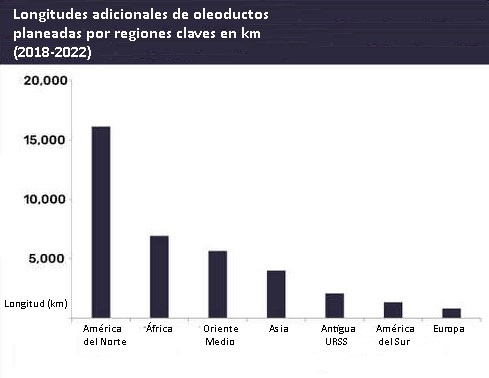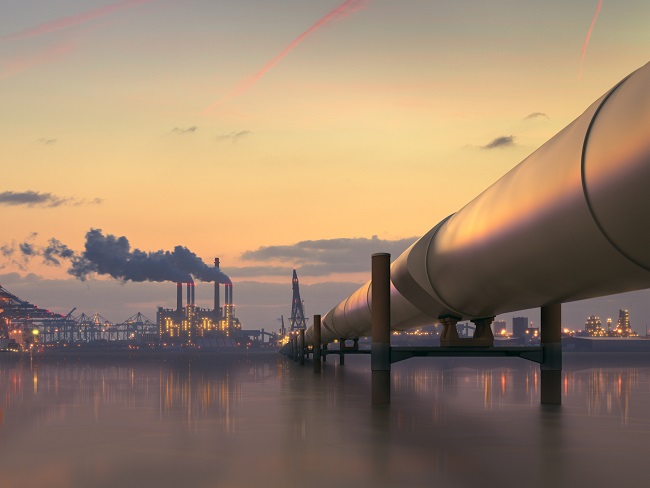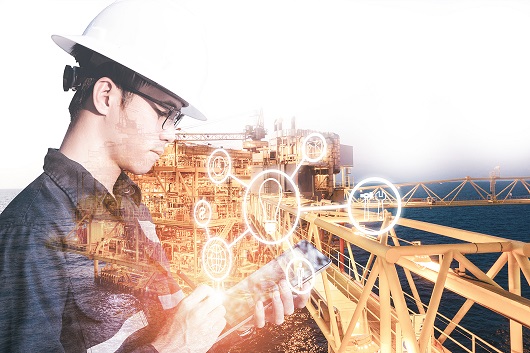Oil and gas pipelines act as veritable arteries inside the Earth. Using extensive steel and plastic pipes, they transport gas and oil throughout the planet. Their strategic influence in the relationships between countries is unquestionable, as they can be used to supply energy to every territory, even when these areas have no natural resources. At present, we are connected by more than 3.5 million kilometers throughout the world. It is expected that by 2022 this figure will increase by 12.2%.
While not as concentrated as oil sources, the sources of natural gas are found throughout the world. The most significant gas pipelines, in terms of both length and volume of flow, are the lines running from Siberia and supplying Europe. Notable among them is the Yamal-Europe, which begins north of Moscow and crosses Belarus, Poland, and Germany. The world’s longest subsea gas pipeline, the Nord Stream, also begins in Russia, in Vyborg, and runs to Germany.
The Old Continent’s energy dependence on Russia occurs also with oil. In fact, the world’s longest oil pipeline, the Druzhba, begins in Russia and extends to Belarus, where it splits into two lines. One line covers Poland and Germany and the other, Ukraine, Hungary, Slovakia, and the Czech Republic, totaling 8,900 kilometers. However, the primary channels for fuel transport are concentrated in the Middle East. The most important lines run to the Red Sea and the Persian Gulf, where there are distribution centers to transfer the crude via ships the whole world over.

Source: Global Crude Oil Pipelines Industry Outlook to 2022, by GlobalData and Upstream Analytics
These pipelines are also strategically important in other regions of the world. This importance exists in Latin America where Gasbol, the most important line, exports from Bolivia to Brazil, along with the gas pipeline that runs from Comodoro Rivadavia in Patagonia to Buenos Aires. Under construction in that same region are the National Unification Gas Pipeline (Gasun), which will connect the Gasbol line in Bolivia with the northern Amazons and the northeast states of Brazil, and the Sur Peruano Gas Pipeline, which will cross the Andes, carrying gas from the Falkland Islands to the coast of Arequipa.
“By 2022, gas and oil pipelines will increase by 12.2%, with Asia building the most kilometers of lines and North America leading investments”

Source: Global Crude Oil Pipelines Industry Outlook to 2022, by GlobalData and Upstream Analytics
The report by the company GlobalData, Global Oil and Gas Pipelines Industry Outlook to 2022, predicts that by 2022, gas and oil pipelines will increase by 12.2%. And although Asia will be the region where the most kilometers of lines will be built — thanks to projects such as the Basra-Aqaba oil pipeline in Iraq — North America will lead in investments, with projects such as the Keystone XL oil pipeline between Canada and the US. In addition, in North America there is the still booming development of the shale gas and shale oil industry, which requires a capillary network of pipelines.
Benefits of the pipelines
The positive forecasts for growth of these channels of transportation are proof that gas and oil continue to be the primary energy resources globally. According to estimates by the Organization of Petroleum Exporting Countries (OPEC), in 2040, they will still cover more than 50% of the planet’s energy needs and the demand for crude will increase by 14.5 million barrels a day from now until that year.
The true potential of these pipelines is that they are transportation systems for hydrocarbons that, thanks to their characteristics, have a number of benefits over traditional channels:
– More economical. In addition to having a higher transportation capacity, they only require energy to start up the centrifugal pumps that push the product through the pipelines. A standard line with a 20-inch diameter can move around one million liters per hour, while a truck can only transport 30,000 liters. Due to that difference and the cost of personnel, transport by truck or ship is up to 15 times more expensive.
– More reliable. They are less exposed to environmental and socioeconomic risks such as earthquakes, strikes, or closed roads. Despite being a slow transportation system (with a speed between 5 and 10 km/h), it is constant, which means it can operate 24 hours per day throughout the year. This ensures that the product always arrives at the correct time to each of the distribution centers.
– Safer. When the pipeline supply control systems detect any loss of fuel, they shut off the flow automatically in the event of any possible leak. As they are normally underground, the rate of serious incidents is far below the rate recorded for transportation on trucks and even trains.

Additionally, as no personnel are needed for their operation and they normally are far from human population centers and transportation routes, the potential hazards are reduced significantly. The environmental impact is also smaller since land and sea transportation produces pollution and noise that is prevented by transporting product through these lines.
Risks Management
Although transporting fuel through these channels is safer, handling hydrocarbons requires a risk-management program capable of preventing contingencies and performing damage repair immediately.
It is essential that an operational risk analysis be performed in order to evaluate all the possible events that could be considered an alarm situation: the probability of each event occurring independently; the vulnerability of the installations; the calculation of risks based on the vulnerability and the probability of it occurring; estimating the impact of each dangerous incident; classifying risks into high, moderate, and low categories; and defining the mitigation measures or design modifications to reduce the possibility of occurrence or impact of the event.
The principal risks these infrastructures are subject to are:
– External mechanical damage. This is the most frequent risk, occurring during work performed around the pipeline with digging or drilling and impacts to the pipe system. Exchange of information, signage, and programs to train and raise awareness among personnel are designed to prevent these incidents.
– Corrosion. In these pipelines, there can be both external corrosion, which is normally due to deterioration of the protective layer, loss of cathodic protection, or a highly aggressive environment, and internal corrosion, normally associated with the characteristics of the liquid being transported, or even metallurgical defects in the base material. Corrosion produces localized defects that reduce the structural integrity of the pipes and can result in leaks. In order to control corrosion, an ultrasonic intelligent pigging inspection must be conducted.
– Loss of support in the terrain where the pipes are located, which can be caused by seismic waves, sinkholes, landslides, flooding, or natural channeling, producing structural damage. It is therefore fundamental that prior analyses of the terrain be carried out, as well as analyses after each incident, to check if there has been deterioration and to perform repairs.
– Wear. Stress during construction and defects in the material can, over time, cause leaks. This means that an exhaustive prior quality analysis of both the materials and procedures must be carried out. Additionally, a strength test prior to initial use, performed at pressures higher than those experienced during operation, will be able to detect defects in the materials and the structure.
– Actions by third parties. Although they are infrequent, theft and sabotage can occur, albeit they are more controlled in the case of underground lines. These possible actions necessitate a security system when lines are exterior, and require fencing and surveillance.
Current surveillance systems can detect and locate leaks based on slight variations in flow or pressure.
A future on technology
“The future of these pipelines is in the application of new technology for their operation and maintenance and in innovation in construction materials”
The safety of these fuel transportation infrastructures has increased as technological progress has allowed for automating processes, monitoring tasks, and compiling enormous amounts of information that promote increased reliability in the implementation of the project.

Nonetheless, there is no doubt that the future of pipelines will depend on how technology can be applied to their construction, operation, and maintenance. Together with the resources inherent in management and control of procedures (operational software, leak detection systems, etc.), new technology is being incorporated more and more into the model, using Data Analytics techniques (Big Data, Artificial Intelligence), based not only on operational data, but also on the data obtained from sensors on devices both internally (pigs) and externally (drones).
In addition to optimizing productivity, these technologies will define how pipeline maintenance is understood, reducing the likelihood of leaks and accelerating repairs. Simultaneously, innovative work is also being focused on the material used to extend the lifespan of pipes, which is currently averaging 20 years.





